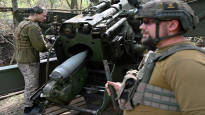In the war in Ukraine, both sides have great difficulties in breaking the front lines of the other, says Doctor of Military Science Ilmari Käihkö
On Tuesday, Russian forces launched a major offensive on the eastern front of the war in Ukraine. The purpose of the attack is most obviously to surround the town of Avdijivka.
Avdijivka, which before the war was a town of 30,000 inhabitants, forms a bend in the front. Already at the beginning of the war, the Russians penetrated twenty kilometers to the west of the city, both in the north and in the south.
War the next Institute for the Study of War (ISW) according to the Russian forces have been attacking since Tuesday in the northwest, west and south of the city. The head of the city’s military administration Vitaliy Barabashin according to ISW, there are 10–12 directions of attack.
The Russian forces are trying to advance with a significantly larger armored force supported by helicopters and artillery. However, according to the Deepstatemap map service, the Russians have moved slowly, only about a kilometer in each direction.
The goal is a blockade
Doctor of military science Ilmari Käihkö believes that the aim of the Russians is to blockade Avdijivka. However, Käihkö points out that progress has been very difficult and the Russians have suffered exceptionally large losses.
It can be seen from the satellite images that Russia has lost at least 45 armored vehicles in its attack, says Käihkö. There are battle tanks, personnel carriers and other vehicles. The large equipment losses also reflect that Russia has invested a lot of power in its attack.
Käihkö thinks that Russia wants to take over Avdijivka, because on its east and north side the land rises into a highland, from which it is easier to control the surrounding farmland. The hills should be conquered now, before the autumn rains soften the ground to the point of impassability. In the spring, it’s a little easier to continue progressing when the high terrain is under your own control.
At the same time, Russia wants to bind Ukrainian forces so that they cannot be concentrated in the Zaporizhzhia region. The same thing happened earlier in the northern part of the front, Käihkö reminds. Ukraine’s defense in Avdijivka is not collapsing, however.
Deadlock
According to Käihkö, the situation in Avdijivka reinforces the perception that the situation in the war in Ukraine is deadlocked, the fronts are not moving at all.
– Passing the front lines is extremely difficult at the moment. There are defensive positions on both sides, and the attacker has to prepare for heavy losses. Achieving breakthroughs is difficult and expensive, Käihkö states.
It is worth noting that Russia is able to move troops away from the Zaporizhzhia front, which means they don’t have a big problem in the south either, where Ukraine has concentrated its biggest attack, Käihkö points out.
Ukraine launched a major offensive in the summer. According to Käihkö, there have still been no significant changes in the frontline since last November, when Ukraine seized Kherson. In May, after a long battle, Russia captured the city of Bahmut.
Newspaper The New York Times according to this, each side has taken over from the other quite exactly the same amount of land during this year. In the end, even significant attacks have been reduced to whether a piece of field is allowed to the other side or not.
Main issues: Black Sea and missile strikes
According to Ilmari Käihkö, the situation at the front is perhaps emphasized too much in the coverage of the war in Ukraine.
– Greater things have been done economically and politically in the Black Sea than what has been achieved by ground warfare, says Käihkö.
Ukraine has been able to create a new transportation channel for its grain, from which the country receives export income. Russia has not tried to prevent cargo ships from going to Ukrainian ports.
In addition, Ukraine has succeeded in evicting the Russian Black Sea Fleet from Crimea. This makes it more difficult for Russia to fire missiles into Ukraine or attack grain ships if it wanted to.
Käihkö also highlights the attacks made by Ukraine on Russian soil. The leadership of Ukraine says that Russia cannot be forced into peace unless the war is brought to Russian soil.
